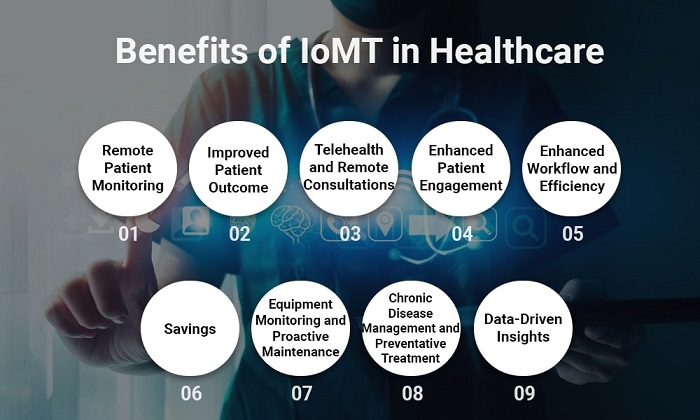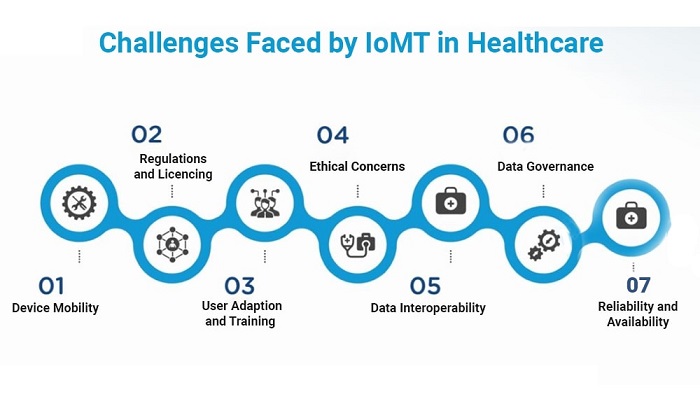Role of the Internet of Medical Things (IoMT) in Healthcare
By linking medical equipment, software, and systems to create a seamless healthcare technology network, the Internet of Medical Things (IoMT) is revolutionizing the healthcare sector. IoMT is transforming how healthcare is delivered today due to the expansion of connected devices and the development of technology like sensors, wearables, and cloud computing. And all of this is done while raising operational efficiency and patient outcomes.
The market for the Internet of Things in healthcare was assessed at USD 252.1 billion in 2022, and from 2023 to 2030, it is anticipated to increase at a CAGR of 16.8%. The market is being pushed by the rise in patient monitoring via smartphones, smart devices, and wearables. The industry is also boosted by the growing use of remote patient monitoring for better out-of-hospital care. The development of linked care and increased investments in adopting digital technology in healthcare facilities are the main drivers promoting industry growth. The market is expanding due to technological developments, an aging population, and a rise in the frequency of chronic diseases.
Let’s explore the idea of IoMT in more detail, examine its many advantages, and identify any possible difficulties when implementing it in ordinary healthcare settings.
Outline of IoMT
The network of interconnected medical devices, sensors, software programs, and systems that gather, transmit, and analyze medical data is known as the Internet of Medical Things (IoMT). IoMT uses internet connectivity and data interchange to revolutionize patient care, raise operational effectiveness, and revolutionize healthcare delivery.
IoMT includes various interconnected devices, such as wearable fitness trackers, mobile healthcare applications, smart medical implants, hospital equipment with embedded sensors, and wearable fitness trackers. These gadgets gather live health information, including vital signs, patient activity, compliance with medication, etc. For instance, a remote patient monitoring system (RPM) provides a healthcare professional with real-time communication of the critical signals of a patient who is chronically sick. It facilitates early diagnosis and timely treatment, sparing the patient’s life.
Additionally, the gathered data is safely communicated to healthcare professionals, carers, or cloud-based platforms for analysis and interpretation. Further, by utilizing cutting-edge analytics & machine learning algorithms, healthcare practitioners can derive valuable information from the data, facilitating early health issue diagnosis, personalized treatment plans, remote patient monitoring, and improved decision-making.
IoMT has a plethora of possible uses. It covers telemedicine consultations, chronic illness management, pharmaceutical management, preventative care, and smart infrastructure optimization for the healthcare industry. Additional examples of IoMT include infusion pumps that provide medication, wearable biosensors, biosensors implanted in people to monitor vital signs, sensors that track drug orders, and medical imaging systems. By delivering individualized, effective, and accessible care while lowering costs and enhancing patient outcomes, it promises to revolutionize healthcare.
Types of IoMT Segments
1. In-home IoMT:
Individuals can submit their medical information to doctors or hospitals from their homes using in-home IoMT. Systems for remote patient monitoring (RPM) measure oxygen and blood pressure. It aids in the early detection of medical problems and decreases hospital readmissions. For minor health issues, telehealth enables people to consult with clinicians at their convenience remotely. Personal emergency response systems (PERS) automatically alert authorities when people fall or have heart attacks. This ensures the safety of those with vulnerabilities, such as older people living alone, and offers prompt help. By enabling patients to take care of themselves and enabling healthcare providers to provide remote, ongoing, and individualized assistance, in-home IoMT is revolutionizing healthcare.
2. Community IoMT:
This type of IoMT includes spreading IoMT devices throughout a larger town or region. While emergency response intelligence systems help paramedics and first responders monitor patient metrics outside the hospital environment, mobility services follow patients while being transported in a vehicle. Revolutionizing the healthcare technologies that allow for remote services are also part of the community IoMT. Kiosks can deliver medications to people in locations with little or no access to traditional infrastructure. At the same time, point-of-care devices can be used in unconventional medical settings like field hospitals.
3. In-clinic and in-hospital IoMT:
IoMT devices are utilized for clinical or administrative purposes in both telehealth and conventional clinic settings. They make it possible for medical personnel to engage and access patients remotely. Hospitals are required to oversee the supply and quality of medical resources as well as the movement of both staff and patients around their facilities. Healthcare professionals may monitor these interactions using IoMT sensors and monitoring systems, which gives administrators an in-depth understanding of the issue. Patient flow management, asset management, inventory management, and environment/energy monitoring are some additional features in this section.
4. On-body IoMT:
For usage outside the house, on-body IoMT includes wearable medical equipment coupled with remote tracking systems. Consumer on-body IoMT devices monitor health data and provide warning signs of potentially serious illnesses. For instance, the Apple Watch can identify abnormal heartbeats. IoMT devices used in clinical settings have a more comprehensive selection of sensors. Patients with diabetes can wear glucose monitors to track their sugar levels and exchange information with their doctors for immediate care. Consumer wearables (fitness gadgets) and wearables made for use in medicine are both included in this IoMT market group. Businesses like Samsung, Misfit, and Fitbit are involved in this area.
IoMT advantages in healthcare
IoMT provides several advantages that improve healthcare outcomes, simplify procedures, and give patients and healthcare professionals more control. In this part, we will examine the impressive benefits of IoMT for the healthcare industry, from improved monitors for patients and personalized therapy plans to increased operational efficiency & cost savings. Let’s discuss a few of the numerous benefits of IoMT in healthcare.
1. Remote Patient Monitoring:
IoMT allows remote monitoring of a patient’s vital signs, symptoms, and medical problems. This enables healthcare professionals to monitor patients’ health outside the typical hospital environment. And this results in earlier problem diagnosis, quicker treatments, and fewer hospital readmissions. Explore the specifics of a remote patient monitoring system by reading this blog.
2. Improved Patient Outcomes:
IoMT enables personalized and proactive care by continually monitoring patients. Healthcare professionals can spot patterns, trends, and abnormalities in inpatient data. This also makes early intervention, individualized treatment campaigns, and better patient results possible.
3. Telehealth and Remote Consultations:
IoMT makes it possible for patients in rural or underserved locations to have access to telehealth services and remote consultations. Additionally, patients may obtain therapy, consultations, and recommendations from doctors in the convenience of their own homes. And doing so would assist in lowering obstacles to care and enhancing access to healthcare. Discover the fundamentals of telemedicine solutions by reading this blog.
4. Enhanced Patient Engagement:
Patients may actively participate in bettering their healthcare by accessing health data via self-monitoring gadgets and personalized health suggestions. It would encourage a sense of responsibility and participation for their welfare.
5. Enhanced Workflow and Efficiency:
IoMT automates repetitive operations, improves resource allocation, and minimizes manual paperwork. The healthcare organization experience increased operational effectiveness and streamlined process as a result. As a result, it enables medical professionals to concentrate more on crucial activities and patient care.
6. Savings:
IoMT contributes to healthcare cost reduction through various methods, such as telehealth services and remote patient monitoring, from lowering healthcare costs related to travel and hospital visits (in rural or underdeveloped locations) to preventing hospital readmissions and unnecessary medical treatments.
7. Equipment Monitoring and Proactive Maintenance:
IoMT helps maintain optimal functionality and performance by continually monitoring medical devices and equipment. And this enables providing preventative maintenance to enhance patient safety, save downtime, and prevent equipment failures.
8. Chronic Disease Management and Preventative Treatment:
It is made more accessible by IoMT, which continually monitors patient health metrics and offers personalized insights. It would enable medical professionals to spot risk factors early and take appropriate action. Therefore stopping the development or progression of chronic diseases. Additionally, IoMT allows for remote monitoring and management of chronic illnesses, lowering hospital visits and enhancing patient quality of life.
9. Data-Driven Insights:
Advanced analytics & machine learning techniques may be used to analyze the enormous volume of generated healthcare data. These observations help recognize trends, patterns, and correlations. And they were making improving illness management, public health initiatives, and research projects possible.
Internet of Medical Things (IoMT) Effect on the Healthcare Sector
By utilizing linked medical devices to make data-driven choices and enhance patient care, IoMT revolutionizes healthcare. Reminders for taking medications and real-time patient monitoring are essential aspects that improve the patient experience overall. Innovative medical tools like watches and pillboxes track medical problems and offer precise diagnoses, giving people the control they need to take control of their health.
The growing demand for connected and wearable technology and devices in the healthcare sector drives the worldwide IoMT market. Due to the advantages of the technology, such as improved medication management, more affordable medical expenses, real-time monitoring, and improved patient outcomes, this market offers several potential opportunities.
IoMT increases efficiency in the healthcare industry by enhancing access control and offering insightful operational data. It allows medical professionals to provide remote medical advice and support, independent of the patient’s location, by gathering and exchanging health data. This leads to better healthcare services, lower costs, and a patient-centric strategy that gives people the power to participate actively in their health.
The following are some of the immediate impacts of IoMT on the healthcare sector:
1. Improved Patient Care:
Providing remote patient monitoring enables medical professionals to get present-day health information and monitor patients’ states outside of conventional medical settings. As a result, patients’ outcomes are eventually improved through more proactive and personalized treatment, including early diagnosis of health concerns and timely therapies, where necessary.
2. Personalized and Preventive Medicine:
The collection of comprehensive patient data, such as vital signs, activity levels, sleep patterns, and medication adherence, is made easier by preventive and personalized medicine. Healthcare professionals use this information to plan individualized treatment and preventative care.
3. Remote and Telehealth Services:
IoMT provides remote consultations, telemedicine, and virtual healthcare services, easing access to healthcare to provide healthcare to remote or underserved locations. Patients may anticipate receiving professional medical guidance, follow-up consultations, and possibly treatment in the convenience of their own homes. Thus, it would assist in lowering obstacles to care & improving healthcare accessibility.
4. Improved Workflow and Efficiency:
Assists in streamlining healthcare operations by automating monotonous procedures, keeping track of inventory levels, allocating resources more effectively, and minimizing human paperwork. Consequently, healthcare organizations see improved workflow, reduced administrative stress, and an overall boost in efficiency.
IoMT Integration in Healthcare: Challenges
There are difficulties in the general acceptance of the Internet of Medical Things, even if it would be the same with the adoption and integration of any other technology. You may get beyond these obstacles and guarantee the success of your project by working with an experienced Healthcare development company.
1. Device Mobility:
Medical institutions’ restricted network capacity makes it difficult to incorporate even mobile devices, regardless of the low-performance capabilities of stationary IoMT devices. The hospital’s wifi may not be safe enough to support a whole IoMT system. Further, mobile devices might come across obstacles that cut off their wireless signal while moving.
2. Regulations and Licencing:
Medical IoT devices must adhere to the laws and get the required licences. However, many companies need to go further in this respect, which might lead to issues and increased legal expenditures. New technologies have to stick to rules, particularly those related to HIPAA. Before being commercialized, clinical-grade medical devices also need the approval of national regulators. As legislators and regulators try to stay up with the rapidly evolving world of healthcare technology, IoMT devices present new difficulties.
3. User Adoption and Training:
For IoMT to be successfully integrated, healthcare workers must quickly adapt to new technologies and workflows. End-users may discover the advantages of IoMT to enhance patient care and workflow efficiency via comprehensive, in-depth training programmes, which also encourage user adoption and acceptance.
4. Ethical Concerns:
Using IoMT might present ethical issues for healthcare organizations. It would cover patient autonomy, data ownership, and consent management. Therefore, it is essential to maintain transparent communication channels with patients, respect their need for privacy, and create ethical standards for data utilization and sharing.
5. Data Interoperability:
Making IoMT devices communicate with one another effectively can be challenging. When exchanging and storing patient data, these devices can run into issues that result in errors and delays. Another problem is that various healthcare system components operate independently, as though they were living in distinct worlds. Additionally, when new IoMT systems are added, there is a chance that they won’t get along with the current ones, which will only make matters worse. The ability of healthcare providers and payers to collaborate effectively and get valuable insights depends on the flawless connection and data sharing between devices.
6. Data Governance:
Managing and obtaining valuable insights from the enormous volumes of data IoMT creates may be difficult. Because of this, adopting precise data governance regulations, data management methods, and advanced analytics tools aid healthcare organizations in properly analyzing & interpreting the data for valuable insights.
7. Reliability and Availability:
Ensuring continuous availability is crucial for healthcare organizations to consider when installing IoMT devices. Maintaining the dependability and availability of IoMT systems would include putting redundancy mechanisms in place, monitoring devices continuously, and performing routine maintenance.
Conclusion
IoMT technology gives up an era of enormous business opportunities as it continues revolutionizing the healthcare sector by linking devices and apps. Our team of skilled healthcare app developers at Flutter Agency can design and create specialized solutions catering to healthcare organizations’ needs. We can thus assist in developing scalable and secure applications to satisfy specific demands, including establishing remote patient monitoring systems, healthcare platforms, or data analytics solutions.
Discover our technological expertise and experience to create, enhance, modernize, or integrate healthcare apps by exploring our healthcare app development services. Our talented developers and designers offer technical advice and can help you with precise planning and estimation throughout your project.
Frequently Asked Questions (FAQs)
1. How can IoMT relate to healthcare?
The network of hardware and software applications and medical equipment connected to the Internet is known as the Internet of Medical Things (IoMT).
2. What role does IoT play in telemedicine and healthcare?
Particularly for patients in remote and underprivileged areas, IoT in healthcare has the potential to broaden access to healthcare services. Patients can get care from the convenience of their homes via telemedicine and remote patient monitoring, which decreases the need for travel and broadens access to care.
3. Why is security crucial for healthcare data?
Security is essential to preserve private patient data, adhere to legal requirements, maintain patient confidentiality, and avoid financial losses. To defend themselves against cyber threats and lessen the dangers of a security breach, healthcare organizations must implement robust security measures.
4. What does healthcare remote patient monitoring mean?
A standard telehealth option is monitoring specific elements of a patient’s health from their home. Remote patient monitoring makes it practical to manage both acute and chronic diseases. Additionally, it lowers the danger of infection and the expense of patient travel.
Contemporary ventures
Recent blog
ready to get started?
Fill out the form below and we will be in touch soon!
"*" indicates required fields











